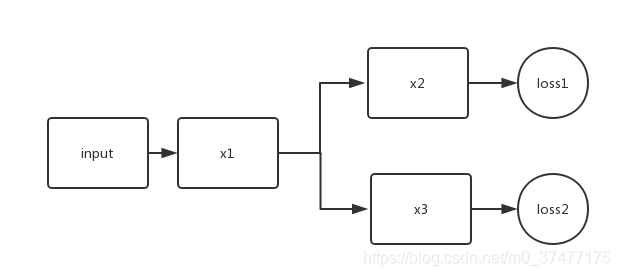жӮЁеҘҪпјҢзҷ»еҪ•еҗҺжүҚиғҪдёӢи®ўеҚ•е“ҰпјҒ
жӮЁеҘҪпјҢзҷ»еҪ•еҗҺжүҚиғҪдёӢи®ўеҚ•е“ҰпјҒ
иҝҷзҜҮж–Үз« е°ҶдёәеӨ§е®¶иҜҰз»Ҷи®Іи§Јжңүе…іkerasеӨҡд»»еҠЎеӨҡlossеӣһдј зҡ„зӨәдҫӢеҲҶжһҗпјҢе°Ҹзј–и§үеҫ—жҢәе®һз”Ёзҡ„пјҢеӣ жӯӨеҲҶдә«з»ҷеӨ§е®¶еҒҡдёӘеҸӮиҖғпјҢеёҢжңӣеӨ§е®¶йҳ…иҜ»е®ҢиҝҷзҜҮж–Үз« еҗҺеҸҜд»ҘжңүжүҖ收иҺ·гҖӮ
еҰӮжһңжңүдёҖдёӘеӨҡд»»еҠЎеӨҡlossзҡ„зҪ‘з»ңпјҢйӮЈд№ҲеңЁи®ӯз»ғж—¶пјҢlossжҳҜеҰӮдҪ•е·ҘдҪңзҡ„е‘ўпјҹ
model = Model(inputs = input, outputs = [y1, y2]) l1 = 0.5 l2 = 0.3 model.compile(loss = [loss1, loss2], loss_weights=[l1, l2], ...)
final_loss = l1 * loss1 + l2 * loss2
жҲ‘们жңҖз»Ҳзҡ„дјҳеҢ–ж•ҲжһңжҳҜжңҖе°ҸеҢ–final_lossгҖӮ
й—®йўҳжқҘдәҶпјҢеңЁи®ӯз»ғиҝҮзЁӢдёӯпјҢжҳҜеҗҰloss2еҸӘжӣҙж–°еҫ—еҲ°y2зҡ„зҪ‘з»ңйҖҡи·ҜпјҢиҝҳжҳҜloss2дјҡжӣҙж–°жүҖжңүзҡ„зҪ‘з»ңеұӮе‘ўпјҹ
жӯӨй—®йўҳзҡ„е…ій”®еңЁжўҜеәҰеӣһдј дёҠпјҢеҚіеҸҚеҗ‘дј ж’ӯз®—жі•гҖӮ


жүҖд»Ҙloss1еҸӘеҜ№x1е’Ңx2жңүеҪұе“ҚпјҢиҖҢloss2еҸӘеҜ№x1е’Ңx3жңүеҪұе“ҚгҖӮ
иЎҘе……пјҡkeras еӨҡдёӘLOSSжҖ»е’Ңе®ҡд№ү

з”Ёеӯ—е…ёеҪўејҸпјҢеҗҚеӯ—жҳҜжЁЎеһӢдёӯиҫ“еҮәйӮЈдёҖеұӮзҡ„еҗҚеӯ—пјҢиҝҷйҮҢзҡ„lossеҸҜд»ҘжҳҜиҮӘе·ұе®ҡд№үзҡ„пјҢд№ҹеҸҜжҳҜиҮӘеёҰзҡ„
иЎҘе……пјҡkerasе®һжҲҳ-еӨҡзұ»еҲ«еҲҶеүІlossе®һзҺ°
жң¬ж–Үж ·дҫӢеқҮдёә3dж•°жҚ®зҡ„onehotж ҮзӯҫеҪўејҸпјҢеҚіy_true(batch_size,x,y,z,class_num)
def dice_coef_fun(smooth=1): def dice_coef(y_true, y_pred): #жұӮеҫ—жҜҸдёӘsampleзҡ„жҜҸдёӘзұ»зҡ„dice intersection = K.sum(y_true * y_pred, axis=(1,2,3)) union = K.sum(y_true, axis=(1,2,3)) + K.sum(y_pred, axis=(1,2,3)) sample_dices=(2. * intersection + smooth) / (union + smooth) #дёҖз»ҙж•°з»„ дёәеҗ„дёӘзұ»еҲ«зҡ„dice #жұӮеҫ—жҜҸдёӘзұ»зҡ„dice dices=K.mean(sample_dices,axis=0) return K.mean(dices) #жүҖжңүзұ»еҲ«diceжұӮе№іеқҮзҡ„dice return dice_coef def dice_coef_loss_fun(smooth=0): def dice_coef_loss(y_true,y_pred): return 1-1-dice_coef_fun(smooth=smooth)(y_true=y_true,y_pred=y_pred) return dice_coef_loss
def generalized_dice_coef_fun(smooth=0): def generalized_dice(y_true, y_pred): # Compute weights: "the contribution of each label is corrected by the inverse of its volume" w = K.sum(y_true, axis=(0, 1, 2, 3)) w = 1 / (w ** 2 + 0.00001) # wдёәеҗ„дёӘзұ»еҲ«зҡ„жқғйҮҚпјҢеҚ жҜ”и¶ҠеӨ§пјҢжқғйҮҚи¶Ҡе°Ҹ # Compute gen dice coef: numerator = y_true * y_pred numerator = w * K.sum(numerator, axis=(0, 1, 2, 3)) numerator = K.sum(numerator) denominator = y_true + y_pred denominator = w * K.sum(denominator, axis=(0, 1, 2, 3)) denominator = K.sum(denominator) gen_dice_coef = numerator / denominator return 2 * gen_dice_coef return generalized_dice def generalized_dice_loss_fun(smooth=0): def generalized_dice_loss(y_true,y_pred): return 1 - generalized_dice_coef_fun(smooth=smooth)(y_true=y_true,y_pred=y_pred) return generalized_dice_loss
# Ref: salehi17, "Twersky loss function for image segmentation using 3D FCDN" # -> the score is computed for each class separately and then summed # alpha=beta=0.5 : dice coefficient # alpha=beta=1 : tanimoto coefficient (also known as jaccard) # alpha+beta=1 : produces set of F*-scores # implemented by E. Moebel, 06/04/18 def tversky_coef_fun(alpha,beta): def tversky_coef(y_true, y_pred): p0 = y_pred # proba that voxels are class i p1 = 1 - y_pred # proba that voxels are not class i g0 = y_true g1 = 1 - y_true # жұӮеҫ—жҜҸдёӘsampleзҡ„жҜҸдёӘзұ»зҡ„dice num = K.sum(p0 * g0, axis=( 1, 2, 3)) den = num + alpha * K.sum(p0 * g1,axis= ( 1, 2, 3)) + beta * K.sum(p1 * g0, axis=( 1, 2, 3)) T = num / den #[batch_size,class_num] # жұӮеҫ—жҜҸдёӘзұ»зҡ„dice dices=K.mean(T,axis=0) #[class_num] return K.mean(dices) return tversky_coef def tversky_coef_loss_fun(alpha,beta): def tversky_coef_loss(y_true,y_pred): return 1-tversky_coef_fun(alpha=alpha,beta=beta)(y_true=y_true,y_pred=y_pred) return tversky_coef_loss
def IoU_fun(eps=1e-6): def IoU(y_true, y_pred): # if np.max(y_true) == 0.0: # return IoU(1-y_true, 1-y_pred) ## empty image; calc IoU of zeros intersection = K.sum(y_true * y_pred, axis=[1,2,3]) union = K.sum(y_true, axis=[1,2,3]) + K.sum(y_pred, axis=[1,2,3]) - intersection # ious=K.mean((intersection + eps) / (union + eps),axis=0) return K.mean(ious) return IoU def IoU_loss_fun(eps=1e-6): def IoU_loss(y_true,y_pred): return 1-IoU_fun(eps=eps)(y_true=y_true,y_pred=y_pred) return IoU_loss
е…ідәҺвҖңkerasеӨҡд»»еҠЎеӨҡlossеӣһдј зҡ„зӨәдҫӢеҲҶжһҗвҖқиҝҷзҜҮж–Үз« е°ұеҲҶдә«еҲ°иҝҷйҮҢдәҶпјҢеёҢжңӣд»ҘдёҠеҶ…е®№еҸҜд»ҘеҜ№еӨ§е®¶жңүдёҖе®ҡзҡ„её®еҠ©пјҢдҪҝеҗ„дҪҚеҸҜд»ҘеӯҰеҲ°жӣҙеӨҡзҹҘиҜҶпјҢеҰӮжһңи§үеҫ—ж–Үз« дёҚй”ҷпјҢиҜ·жҠҠе®ғеҲҶдә«еҮәеҺ»и®©жӣҙеӨҡзҡ„дәәзңӢеҲ°гҖӮ
е…ҚиҙЈеЈ°жҳҺпјҡжң¬з«ҷеҸ‘еёғзҡ„еҶ…е®№пјҲеӣҫзүҮгҖҒи§Ҷйў‘е’Ңж–Үеӯ—пјүд»ҘеҺҹеҲӣгҖҒиҪ¬иҪҪе’ҢеҲҶдә«дёәдё»пјҢж–Үз« и§ӮзӮ№дёҚд»ЈиЎЁжң¬зҪ‘з«ҷз«ӢеңәпјҢеҰӮжһңж¶үеҸҠдҫөжқғиҜ·иҒ”зі»з«ҷй•ҝйӮ®з®ұпјҡis@yisu.comиҝӣиЎҢдёҫжҠҘпјҢ并жҸҗдҫӣзӣёе…іиҜҒжҚ®пјҢдёҖз»ҸжҹҘе®һпјҢе°Ҷз«ӢеҲ»еҲ йҷӨж¶үе«ҢдҫөжқғеҶ…е®№гҖӮ